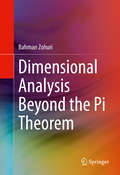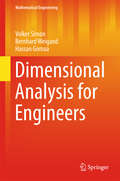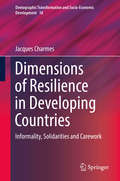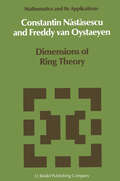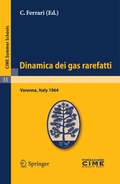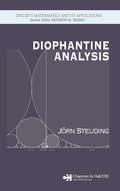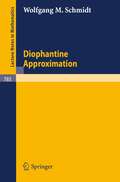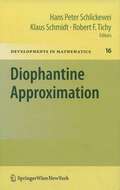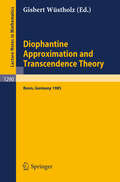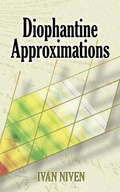- Table View
- List View
Dimensional Analysis Beyond the Pi Theorem
by Bahman ZohuriDimensional Analysis and Physical Similarity are well understood subjects, and the general concepts of dynamical similarity are explained in this book. Our exposition is essentially different from those available in the literature, although it follows the general ideas known as Pi Theorem. There are many excellent books that one can refer to; however, dimensional analysis goes beyond Pi theorem, which is also known as Buckingham’s Pi Theorem. Many techniques via self-similar solutions can bound solutions to problems that seem intractable.A time-developing phenomenon is called self-similar if the spatial distributions of its properties at different points in time can be obtained from one another by a similarity transformation, and identifying one of the independent variables as time. However, this is where Dimensional Analysis goes beyond Pi Theorem into self-similarity, which has represented progress for researchers.In recent years there has been a surge of interest in self-similar solutions of the First and Second kind. Such solutions are not newly discovered; they have been identified and named by Zel’dovich, a famous Russian Mathematician in 1956. They have been used in the context of a variety of problems, such as shock waves in gas dynamics, and filtration through elasto-plastic materials.Self-Similarity has simplified computations and the representation of the properties of phenomena under investigation. It handles experimental data, reduces what would be a random cloud of empirical points to lie on a single curve or surface, and constructs procedures that are self-similar. Variables can be specifically chosen for the calculations.
Dimensional Analysis for Engineers (Mathematical Engineering)
by Volker Simon Bernhard Weigand Hassan GomaaThis monograph provides the fundamentals of dimensional analysis and illustrates the method by numerous examples for a wide spectrum of applications in engineering. The book covers thoroughly the fundamental definitions and the Buckingham theorem, as well as the choice of the system of basic units. The authors also include a presentation of model theory and similarity solutions. The target audience primarily comprises researchers and practitioners but the book may also be suitable as a textbook at university level.
Dimensionality Reducing Expansion of Multivariate Integration
by Tian-Xiao HeThis book focuses primarily on a powerful tool: dimensionality reducing expansion (DRE). The method of DRE is a technique for changing a higher dimensional integration to a lower dimensional one with or without remainder. This work will appeal to a broad audience of students and researchers in pure and applied mathematics, statistics, and physics.
Dimensions and Entropies in Chaotic Systems: Quantification of Complex Behavior Proceeding of an International Workshop at the Pecos River Ranch, New Mexico, September 11–16, 1985 (Springer Series in Synergetics #32)
by Gottfried Mayer-KressThese proceedings contain the papers contributed to the International Work shop on "Dimensions and Entropies in Chaotic Systems" at the Pecos River Conference Center on the Pecos River Ranch in Spetember 1985. The work shop was held by the Center for Nonlinear Studies of the Los Alamos National Laboratory. At the Center for Nonlinear Studies the investigation of chaotic dynamics and especially the quantification of complex behavior has a long tradition. In spite of some remarkable successes, there are fundamental, as well as nu merical, problems involved in the practical realization of these algorithms. This has led to a series of publications in which modifications and improve ments of the original methods have been proposed. At present there exists a growing number of competing dimension algorithms but no comprehensive review explaining how they are related. Further, in actual experimental ap plications, rather than a precise algorithm, one finds frequent use of "rules of thumb" together with error estimates which, in many cases, appear to be far too optimistic. Also it seems that questions like "What is the maximal dimension of an attractor that one can measure with a given number of data points and a given experimental resolution?" have still not been answered in a satisfactory manner for general cases.
Dimensions of Resilience in Developing Countries: Informality, Solidarities and Carework (Demographic Transformation and Socio-Economic Development #10)
by Jacques CharmesThis book provides the latest empirical data on the three forms of resilience: informality, solidarities and unpaid care-work. It uncovers and quantifies these three forms of resilience that are generally invisible or ill recognised, whereas these play a major role in the livelihoods of poor and vulnerable populations. The book shows how the slow but constant unveiling of these forms over the past four decades has gradually changed our vision of progress and development and is impacting the norms and concepts that shape our vision of the economy and society. The book also emphasizes the role of informal economy through explaining the origins of the concept, its definitions and the methods of data collection and measurement. As such the book will be of interest to students, researchers and policy makers in population studies, economics, and international development.
Dimensions of Ring Theory (Mathematics and Its Applications #36)
by C. Nastasescu Freddy Van OystaeyenApproach your problems from the right end It isn't that they can't see the solution. It is and begin with the answers. Then one day, that they can't see the problem. perhaps you will find the final question. G. K. Chesterton. The Scandal of Father 'The Hermit Gad in Crane Feathers' in R. Brown 'The point of a Pin'. van Gulik's The Chinese Maze Murders. Growing specialization and diversification have brought a host of monographs and textbooks on increasingly specialized topics. However, the "tree" of knowledge of mathematics and related fields does not grow only by putting forth new branches. It also happens, quite often in fact, that branches which were thought to be completely disparate are suddenly seen to be related. Further, the kind and level of s9phistication of mathematics applied in various sciences has changed drastically in recent years: measure theory is used (non trivially) in regional and theoretical economics; algebraic geometry interacts with physics; the Minkowsky lemma, coding theory and the structure of water meet one another in packing and covering theory; quantum fields, crystal defects and mathematical programming profit from homotopy theory; Lie algebras are relevant to filtering; and prediction and electrical engineering can use Stein spaces. And in addition to this there are such new emerging subdisciplines as "experimental mathematics", "CFD", "completely integrable systems", "chaos, synergetics and large-scale order", which are almost impossible to fit into the existing classification schemes. They draw upon widely different sections of mathematics.
Dimensionsanalyse in der Strömungslehre
by Joseph H. SpurkDimensionsbetrachtungen reichen bis in die Anfänge der Mechanik und besonders der Strömungslehre zurück. Zu der Fortentwicklung dieser Wissenschaften und zu dem Er kenntnisfortschritt der Naturwissenschaften allgemein haben Dimensionsbetrachtungen wesentliche Beiträge geliefert und oft richtungsweisend neue Wissensgebiete eröffnet. Leider verdeckt der Hinweis auf dimensions analytisch begründete Ansätze leicht die hin ter diesen Ansätzen stehende geistige Leistung und verführt zur Annahme, daß sich die Mühen neuer Erkenntnisse durch hastige, rezeptartige Anwendungen dimensionsana lytischer Methoden vermeiden ließen. Gescheiterte Ansätze und bittere Enttäuschun gen sind die Folge und einhergehend die Ablehnung dieser Methoden überhaupt. Der leichtfertige Umgang mit Dimensionsbetrachtungen wird durch Lehrbücher gefördert, die Rezepturen in den Vordergrund stellen und an (wohl bekannten) Beispielen zei gen, wie leicht, ans Wunderbare grenzend, sich physikalische Erkenntnisse von tiefer Bedeutung gewinnen lassen. Die formale Dimensionsanalyse kann aber aus einer Pro blemstellung nur die, für die Lösung unwichtige, Information entfernen, die über das Maßsystem eingetreten ist. Das stellt noch keine physikalische Erkenntnis dar. Daher kann die formale Durchführung der Dimensionsanalyse nicht im Vordergrund stehen, zumal diese fast trivial ist. Im Vordergrund steht vielmehr die Durchdringung der ge gebenen Fragestellung, die Abstraktion und Vereinfachung des Problems, die es erst gestattet, die relevanten physikalischen Größen zu erkennen und damit ihre Zahl auf das für die Beschreibung absolut notwendige Minimum zu beschränken. Erst dann ist eine Dimensionsanalyse sinnvoll, weil sie die notwendige Zahl der Veränderlichen wei ter reduziert. Aber dieser Satz der neuen Veränderlichen ist nicht eindeutig.
Dimensionshomogenität: Erkenntnis ohne Wissen?
by Jochem Unger Stephan LeyerDieses Buch leistet übergeordnet einen besonderen Beitrag zur dauerhaften innovativen Weiterentwicklung und Kompetenzerhaltung. Es enthält Hinweise zur Beurteilung der Sinnhaftigkeit von Computerprogrammen und Entscheidungen, die allein auf die Vergleichsgröße Geld mit dem damit zwangsweise verknüpften technischen Informationsverlust reduziert sind, um den industriellen Prozesses zum Wohl aller Menschen unbeirrt erfolgreich fortsetzen zu können. Gesichertes Wissen kann nur aus der Natur abgeleitetes Wissen sein. Die Denk- und Arbeitsweisen der Ingenieure und Physiker als treibende Hauptakteure müssen naturwissenschaftlich geprägt sein. Der heute zu beobachtenden geradezu explosionsartigen Vermehrung an Faktenwissen steht eine ebenso schnelle Entwertung des technischen Details gegenüber, die man mit dem Einsatz von Computerprogrammen zu beherrschen glaubt. Um unter diesen Bedingungen wirklich Herr der Dinge bleiben zu können, sind grundlegende, allein durch die Naturgesetze und die Mathematik legitimierte, Denk- und Arbeitsmethoden zu nutzen und weiterzuentwickeln, die in der Zeit des Faktenwissens und Computergebrauchs sonst verloren gehen. Das naturwissenschaftlich/mathematische Werkzeug hierzu ist die ¶-Theorem Methodik, die universell auf alle technologischen Probleme (Mechanik, Elektrotechnik, Biologie, Populationen, …) angewendet werden kann. Da jedes spezielle technologische Problem ein ganz extremer Sonderfall ist, kann stets durch Verschärfen und Ausschöpfen mit a priori bekannten problemspezifischen Details und Nutzung von Reihenentwicklungen immer eine extrem einfache natur-wissenschaftlich gesicherte Lösung gefunden werden, die zugleich auch ökonomisch hinsichtlich Zeit- und Kostenaufwand optimal ist. Der InhaltEinführung - ¶-Theorem - Elementare Anwendungen - Effizienz der ¶-Theorem Methodik - Modell und Original - Monetär-technologisches Wechselspiel - Allometrie - Naturkonstanten - Praktische Handhabung und Kunst der Modellwahl - Übungsaufgaben und Lösungen
Dimensionstheorie
by Karl MengerDieser Buchtitel ist Teil des Digitalisierungsprojekts Springer Book Archives mit Publikationen, die seit den Anfängen des Verlags von 1842 erschienen sind. Der Verlag stellt mit diesem Archiv Quellen für die historische wie auch die disziplingeschichtliche Forschung zur Verfügung, die jeweils im historischen Kontext betrachtet werden müssen. Dieser Titel erschien in der Zeit vor 1945 und wird daher in seiner zeittypischen politisch-ideologischen Ausrichtung vom Verlag nicht beworben.
Dimensionstheorie (essentials)
by Jörg NeunhäusererDieses Essential gibt eine kompakte Einführung in die Dimensionstheorie. Die topologische Dimension und mehrere fraktale Dimensionen werden definiert und anhand von Beispielen erläutert. Lesende lernen grundlegende Sätze über die Dimension von kartesischen Produkten, Projektionen, Schnitten und arithmetischen Summen kennen. Weiterhin wird eine Vielfalt von Anwendungen der Dimensionstheorie in der Zahlentheorie, der Geometrie, der Analysis, den dynamischen Systemen und der Stochastik vorgestellt.
Dinamica dei gas rarefatti: Lectures given at a Summer School of the Centro Internazionale Matematico Estivo (C.I.M.E.) held in Varenna (Como), Italy, August 21-29, 1964 (C.I.M.E. Summer Schools #33)
by C. FerrariC. Ferrari: Premessa.- M.S.v. Krzywoblocki: The mathematical aspects of rarefied gas dynamics as applied to hypersonic, reentry and magneto-ggas-dynamics.- J. Kampé de Fériet: La théorie de l´information et la mécanique statistique classique des systèmes en équilibre.- M. Lunc: Equations de transport.- I. Estermann: 1. Applications of molecular beams to problems in rarefied gas dynamics. 2. Experimental methods in rarefied gas dynamics.- S. Nocilla: Sull´integrazione tra flussi di molecole libere e superfici rigide.- F. Sernagiotto: Solution of Rayleigh’s problem for the whole range of Knudsen numbers.- G. Tironi: Linearized Rayleigh’s Problem in magnetogasdynamics.- D. Graffi: Alcuni richiami sulla ionosfera.- C. Agostinelli: Le equazioni delle onde d’urto in un gas rarefatto elettricamente conduttore soggetto a un campo magnetico.
Dinaric Perspectives on TIMSS 2019: Teaching and Learning Mathematics and Science in South-Eastern Europe (IEA Research for Education #13)
by Barbara Japelj Pavešić Paulína Koršňáková Sabine MeinckThis open access book brings together national experts from across the Dinaric region to rigorously review IEA’s Trends in International Mathematics and Science Study (TIMSS) 2019 grade four data to develop a multidimensional and culturally sensitive perspective on their TIMSS 2019 primary-level results. The Dinaric region, named after the Dinaric Alps, is located in South-eastern Europe, and stretches through Croatia, Bosnia and Herzegovina, Serbia, Montenegro, Kosovo[1], Albania, and North Macedonia. IEA’s TIMSS has been an invaluable resource for monitoring international trends in mathematics and science achievement at grades four and eight since 1995. The TIMSS 2019 administration of the test to grade four students, provided a unique opportunity for analysis within shared regional settings and enabled the construction of this first report based on international study results from the region, prepared by the National Research Coordinators in collaboration with IEA. [1] This designation is without prejudice to positions on status and is in line with UNSCR 1244/1999 and the ICJ Opinion on the Kosovo declaration of independence.
DIOCLES, On Burning Mirrors: The Arabic Translation of the Lost Greek Original (Sources in the History of Mathematics and Physical Sciences #1)
by G. J. ToomerThis publication would not have been what it is without the help of many institutions and people, which I acknowledge most gratefully. I thank the Central Library and Documentation Center, Iran, and its director, Mr. Iraji Afshar, for permission to publish photo graphs of that part of ms. 392 of the Shrine Library, Meshhed, containing Diocles' treatise. I also thank the authorities of the Shrine Library, and especially Mr. Ahmad GolchTn-Ma'anT, for their cooperation in providing photographs of the manuscript. Mr. GolchTn Ma'anT also sent me, most generously, a copy of his catalogue of the astronomical and mathematical manuscripts of the Shrine Library. I am grateful to the Chester Beatty Library, Dublin, and the Universiteits-Bibliotheek, Leid'en, for providing me with microfilms of manuscripts I wished to consult, and to the Biblioteca Ambrosiana, Milan, for granting me access to its manuscripts. The text pages in Arabic script and the Index of Technical Terms were set by a computer-assisted phototypesetting system, using computer programs developed at the University of Washington and a high-speed image-generation phototypesetting device. A continuous stream of text on punched cards was fed through the Katib formatting program, which broke up the text into lines and pages and arranged the section numbers and apparatus on each page. Output from Katib was fed through the compositor program Hattat to create a magnetic tape for use on the VideoComp phototypesetter.
Diophantine Analysis: Course Notes from a Summer School (Trends in Mathematics)
by Sanda Bujačić Alan Filipin Simon Kristensen Tapani Matala-Aho Nicola M.R. OswaldThis collection of course notes from a number theory summer school focus on aspects of Diophantine Analysis, addressed to Master and doctoral students as well as everyone who wants to learn the subject. The topics range from Baker’s method of bounding linear forms in logarithms (authored by Sanda Bujačić and Alan Filipin), metric diophantine approximation discussing in particular the yet unsolved Littlewood conjecture (by Simon Kristensen), Minkowski’s geometry of numbers and modern variations by Bombieri and Schmidt (Tapani Matala-aho), and a historical account of related number theory(ists) at the turn of the 19th Century (Nicola M.R. Oswald). Each of these notes serves as an essentially self-contained introduction to the topic. The reader gets a thorough impression of Diophantine Analysis by its central results, relevant applications and open problems. The notes are complemented with many references and an extensive register which makes it easy to navigate through the book.
Diophantine Analysis (Discrete Mathematics And Its Applications Ser.)
by Jorn SteudingWhile its roots reach back to the third century, diophantine analysis continues to be an extremely active and powerful area of number theory. Many diophantine problems have simple formulations, they can be extremely difficult to attack, and many open problems and conjectures remain. Diophantine Analysis examines the theory of diophantine ap
Diophantine Approximation: Lectures given at the C.I.M.E. Summer School held in Cetraro, Italy, June 28 – July 6, 2000 (Lecture Notes in Mathematics #1819)
by David Masser Yuri V. Nesterenko Hans Peter Schlickewei Wolfgang M. Schmidt Michel WaldschmidtDiophantine Approximation is a branch of Number Theory having its origins intheproblemofproducing“best”rationalapproximationstogivenrealn- bers. Since the early work of Lagrange on Pell’s equation and the pioneering work of Thue on the rational approximations to algebraic numbers of degree ? 3, it has been clear how, in addition to its own speci?c importance and - terest, the theory can have fundamental applications to classical diophantine problems in Number Theory. During the whole 20th century, until very recent times, this fruitful interplay went much further, also involving Transcend- tal Number Theory and leading to the solution of several central conjectures on diophantine equations and class number, and to other important achie- ments. These developments naturally raised further intensive research, so at the moment the subject is a most lively one. This motivated our proposal for a C. I. M. E. session, with the aim to make it available to a public wider than specialists an overview of the subject, with special emphasis on modern advances and techniques. Our project was kindly supported by the C. I. M. E. Committee and met with the interest of a largenumberofapplicants;forty-twoparticipantsfromseveralcountries,both graduatestudentsandseniormathematicians,intensivelyfollowedcoursesand seminars in a friendly and co-operative atmosphere. The main part of the session was arranged in four six-hours courses by Professors D. Masser (Basel), H. P. Schlickewei (Marburg), W. M. Schmidt (Boulder) and M. Waldschmidt (Paris VI). This volume contains expanded notes by the authors of the four courses, together with a paper by Professor Yu. V.
Diophantine Approximation: Festschrift for Wolfgang Schmidt (Developments in Mathematics)
by Robert F. Tichy Hans Peter Schlickewei Klaus SchmidtThis volume contains 21 research and survey papers on recent developments in the field of diophantine approximation, which are based on lectures given at a conference at the Erwin Schrödinger-Institute (Vienna, 2003). The articles are either in the spirit of more classical diophantine analysis or of a geometric or combinatorial flavor. Several articles deal with estimates for the number of solutions of diophantine equations as well as with congruences and polynomials.
Diophantine Approximation and Abelian Varieties: Introductory Lectures (Lecture Notes in Mathematics #1566)
by Bas Edixhoven Jan-Hendrik EvertseThe 13 chapters of this book centre around the proof of Theorem 1 of Faltings' paper "Diophantine approximation on abelian varieties", Ann. Math.133 (1991) and together give an approach to the proof that is accessible to Ph.D-level students in number theory and algebraic geometry. Each chapter is based on an instructional lecture given by its author ata special conference for graduate students, on the topic of Faltings' paper.
Diophantine Approximation and Dirichlet Series (Texts and Readings in Mathematics #80)
by Hervé Queffelec Martine QueffelecThe second edition of the book includes a new chapter on the study of composition operators on the Hardy space and their complete characterization by Gordon and Hedenmalm. The book is devoted to Diophantine approximation, the analytic theory of Dirichlet series and their composition operators, and connections between these two domains which often occur through the Kronecker approximation theorem and the Bohr lift. The book initially discusses Harmonic analysis, including a sharp form of the uncertainty principle, Ergodic theory and Diophantine approximation, basics on continued fractions expansions, and the mixing property of the Gauss map and goes on to present the general theory of Dirichlet series with classes of examples connected to continued fractions, Bohr lift, sharp forms of the Bohnenblust–Hille theorem, Hardy–Dirichlet spaces, composition operators of the Hardy–Dirichlet space, and much more. Proofs throughout the book mix Hilbertian geometry, complex and harmonic analysis, number theory, and ergodic theory, featuring the richness of analytic theory of Dirichlet series. This self-contained book benefits beginners as well as researchers.
Diophantine Approximation and Dirichlet Series
by Herve Queffelec Martine QueffelecThis self-contained book will benefit beginners as well as researchers. It is devoted to Diophantine approximation, the analytic theory of Dirichlet series, and some connections between these two domains, which often occur through the Kronecker approximation theorem. Accordingly, the book is divided into seven chapters, the first three of which present tools from commutative harmonic analysis, including a sharp form of the uncertainty principle, ergodic theory and Diophantine approximation to be used in the sequel. A presentation of continued fraction expansions, including the mixing property of the Gauss map, is given. Chapters four and five present the general theory of Dirichlet series, with classes of examples connected to continued fractions, the famous Bohr point of view, and then the use of random Dirichlet series to produce non-trivial extremal examples, including sharp forms of the Bohnenblust-Hille theorem. Chapter six deals with Hardy-Dirichlet spaces, which are new and useful Banach spaces of analytic functions in a half-plane. Finally, chapter seven presents the Bagchi-Voronin universality theorems, for the zeta function, and r-tuples of L functions. The proofs, which mix hilbertian geometry, complex and harmonic analysis, and ergodic theory, are a very good illustration of the material studied earlier.
Diophantine Approximation and Transcendence Theory: Seminar, Bonn (FRG) May - June 1985 (Lecture Notes in Mathematics #1290)
by Gisbert WüstholzDiophantine Approximation on Linear Algebraic Groups: Transcendence Properties of the Exponential Function in Several Variables (Grundlehren der mathematischen Wissenschaften #326)
by Michel WaldschmidtThe theory of transcendental numbers is closely related to the study of diophantine approximation. This book deals with values of the usual exponential function ez: a central open problem is the conjecture on algebraic independence of logarithms of algebraic numbers. Two chapters provide complete and simplified proofs of zero estimates (due to Philippon) on linear algebraic groups.
Diophantine Approximations (Dover Books on Mathematics)
by Ivan NivenThis self-contained treatment originated as a series of lectures delivered to the Mathematical Association of America. It covers basic results on homogeneous approximation of real numbers; the analogue for complex numbers; basic results for nonhomogeneous approximation in the real case; the analogue for complex numbers; and fundamental properties of the multiples of an irrational number, for both the fractional and integral parts.The author refrains from the use of continuous fractions and includes basic results in the complex case, a feature often neglected in favor of the real number discussion. Each chapter concludes with a bibliographic account of closely related work; these sections also contain the sources from which the proofs are drawn.
Diophantine Approximations and Diophantine Equations (Lecture Notes in Mathematics #1467)
by Wolfgang M. Schmidt"This book by a leading researcher and masterly expositor of the subject studies diophantine approximations to algebraic numbers and their applications to diophantine equations. The methods are classical, and the results stressed can be obtained without much background in algebraic geometry. In particular, Thue equations, norm form equations and S-unit equations, with emphasis on recent explicit bounds on the number of solutions, are included. The book will be useful for graduate students and researchers." (L'Enseignement Mathematique) "The rich Bibliography includes more than hundred references. The book is easy to read, it may be a useful piece of reading not only for experts but for students as well." Acta Scientiarum Mathematicarum
